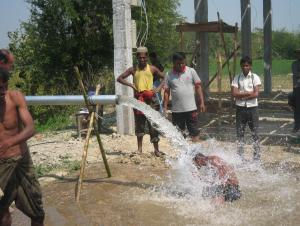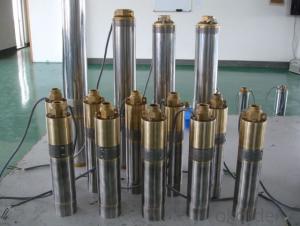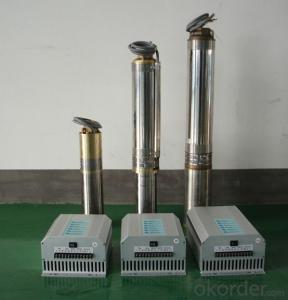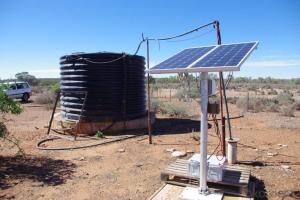DC Solar Pumping Systems Popular Type Good Quality
- Loading Port:
- Shekou
- Payment Terms:
- TT OR LC
- Min Order Qty:
- 10 set
- Supply Capability:
- 6000000 set/month
OKorder Service Pledge
OKorder Financial Service
You Might Also Like
Products
DC Solar Pumping System can be applied to daily use (ground water), agricultural irrigation, forestry irrigation, desert control, pasture animal husbandry, water supply for islands, wastewater treatment engineering, and so on. Solar water pump System is dispensed with energy storing devices, and stores water instead of electricity. It improves the reliability of the device, at the same time, it lowers the construction and maintenance costs of the irrigation system dramatically.
In recent years, with the promotion of the utilization of new energy resources, Solar Pumping System is more and more used in municipal engineering, city centre squares, parks, tourist sites, resorts and hotels, the landscapes and fountain irrigation systems in the residential areas.
Technical Features
Optimization of Single Pump System
A single solar irrigation system consists of only one pump, a power -matched solar array and an inverter . The aim of optimization is to reduce the amount of PV modules as much as possible on the premise of filling the requirement of head and capacity. The rotational speed of pump is regulated according to the irradiation on the solar array; when the sunlight reaches its peak, the pump runs at the rated speed, and the output approaches the peak power of the solar array; when the sunlight is less abundant, the speed of pump varies bellow the range of the rated speed; when the speed as low as the capacity becomes zero, the solar pumping system stops working. So, there are big differences between solar irriation systems and traditional pumping systems in system design, and the system should be optimized according to the requirements of head, capacity, and local conditions of sunlight.
•Determine the optimal average daily operating time and the range of speed governing.
•Choose the optimal head and capacity of the pump.
•Determine the maximum power of PV modules, the best working voltage and method of connection.
Optimization of Multi-pump Systems:
There are several pumps in a multi-pump system. The pumps can be driven either by only one high-power inverter, or by several matching inverters. In the case of large capacity demand, the operation of the multi-pump system is more flexible. By switching solar arrays and pumps, all of the pumps run in MPPT mode when the sunlight is abundant, while some pumps will be shut down and all solar arrays supply power intensively for the rest running pumps when irradiation is weak. Based on the optimization of single pump system, the range of speed can be further optimized, and the photovoltaic(PV) pumping system always works with high efficiency.
Product Specifications
Model | Rated Power | Max. Flow | Max. Lift | Daily Water Supply | Outlet Dia. | Pump Dia. |
PSD600C | 600W | 4.5 m3/h | 30 m | 10 - 20 m3 | 1"1/4 | 4" |
PSD600H | 600W | 2 m3/h | 100 m | 5 - 10 m3 | 1"1/4 | 4" |
Solar Array Configuration
Max. Input Power | Max. Input Current | Max. Open Circuit Voltage | Recommended MPP Voltage |
1000W | 15A | 150VDC | 60 - 120VDC |
Recommended Design | Solar Panel | Connection | Total Power |
Configuration 1 | 190W / 35Vmp | 2 pcs x 2 strings | 760W |
Configuration 2 | 250W / 30Vmp | 3 pcs x 1 string | 750W |
Performance Curve
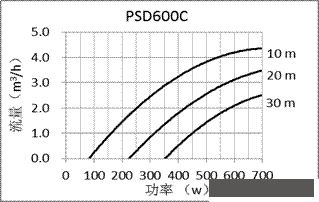
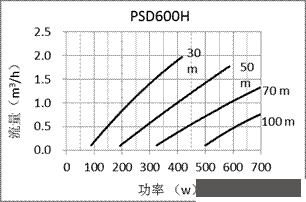
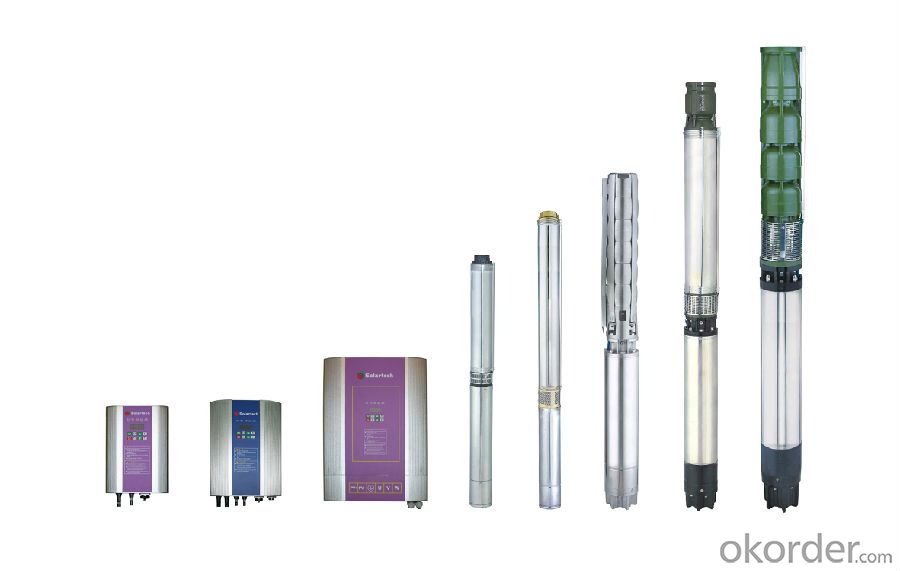
- Q:What is the expected noise level of a solar pump during operation?
- The expected noise level of a solar pump during operation is typically very low, as solar pumps are designed to operate quietly and efficiently. The noise level can vary depending on the specific model and size of the pump, but in general, it is significantly quieter compared to traditional pumps powered by electricity or fuel.
- Q:How does the size of the pump motor affect the performance of a solar pump?
- The size of the pump motor plays a crucial role in determining the performance of a solar pump. The motor size directly influences the flow rate, pressure, and overall efficiency of the pump. A larger pump motor typically allows for a higher flow rate, which means more water can be pumped in a given time. This is especially important in situations where a substantial amount of water needs to be moved, such as for agricultural irrigation or large-scale water supply systems. A higher flow rate ensures that the desired volume of water is delivered effectively and efficiently. Additionally, the size of the pump motor affects the pressure that the pump can generate. A larger motor can create higher pressure, which is necessary for pumping water to higher elevations or overcoming resistance in a long pipe network. Higher pressure ensures that water reaches its intended destination with sufficient force and can be distributed evenly across the irrigation system or other applications. Furthermore, a larger motor is often associated with improved efficiency. With a more powerful motor, the pump requires less time to complete its pumping cycle, reducing energy consumption. This translates into cost savings and a more sustainable use of solar energy. It is important to note that while a larger motor generally offers higher performance, it also requires more energy to operate. Therefore, it is essential to strike a balance between motor size and energy availability. If the solar array powering the pump is not able to generate sufficient electricity to operate a larger motor, it may be necessary to opt for a smaller motor that can still meet the required performance levels without exceeding the available energy supply. In conclusion, the size of the pump motor has a significant impact on the performance of a solar pump. A larger motor allows for higher flow rates, increased pressure, and improved efficiency. However, it is essential to consider the available energy supply when selecting the motor size to ensure optimal performance and energy utilization.
- Q:Can a solar pump be used in residential applications?
- Yes, a solar pump can be used in residential applications. Solar pumps are an efficient and environmentally friendly alternative to traditional electric pumps in residential settings. They can be used for various purposes such as supplying water for irrigation, livestock, or even for household use. Additionally, solar pumps can help reduce electricity costs and dependency on the grid, making them a viable option for residential applications.
- Q:How do solar pumps handle water with high fluoride or chemical content?
- Solar pumps do not specifically handle water with high fluoride or chemical content. However, in general, solar pumps are designed to efficiently lift and distribute water from a source, regardless of its chemical composition. If the water contains high fluoride or chemical content, additional treatment methods such as filtration or water conditioning may be required to ensure safe and suitable usage.
- Q:Can a solar pump operate at night?
- No, a solar pump cannot operate at night as it requires sunlight to generate power and function.
- Q:Can a solar pump be used in areas with freezing temperatures?
- Yes, a solar pump can be used in areas with freezing temperatures. However, precautions need to be taken to prevent damage to the pump and its components. This can be achieved by using appropriate insulation, heat tracing, or placing the pump in a heated enclosure. Additionally, the pump should be designed to handle freezing conditions and the water source should be properly protected to prevent freezing.
- Q:Can solar pumps be used for water supply in remote healthcare clinics or facilities?
- Yes, solar pumps can be used for water supply in remote healthcare clinics or facilities. Solar pumps are a viable and sustainable solution for providing a reliable water source in areas with limited or no access to electricity. They utilize solar energy to power the pump and draw water from underground sources such as wells or boreholes. This ensures a consistent water supply for essential healthcare services, including drinking water, sanitation, and hygiene. Additionally, solar pumps are environmentally friendly and cost-effective in the long run, making them an ideal choice for remote healthcare facilities.
- Q:What are the safety measures to be taken while installing a solar pump?
- When installing a solar pump, several safety measures should be taken to ensure the protection of individuals and the equipment. These measures include proper grounding of the system to prevent electrical hazards, wearing appropriate personal protective equipment (PPE) like gloves and safety goggles, following manufacturer's instructions and guidelines, and ensuring that all electrical connections are secure and insulated. It is also important to conduct a thorough risk assessment of the installation site, including identifying potential hazards such as uneven terrain or overhead power lines, and taking necessary precautions to mitigate those risks. Additionally, regular maintenance and inspections should be performed to ensure the safe operation of the solar pump system.
- Q:What is the lifespan of a solar panel used in a solar pump system?
- The lifespan of a solar panel used in a solar pump system can vary depending on various factors such as the quality of the panel, maintenance practices, and environmental conditions. On average, a well-maintained and high-quality solar panel can last anywhere from 25 to 30 years. However, it is important to note that the efficiency of the panel may gradually decrease over time, resulting in a slightly reduced output. Regular cleaning, monitoring, and maintenance can help maximize the lifespan and performance of the solar panel in a solar pump system.
- Q:Are there any maintenance requirements for the solar panels used in a solar pump system?
- Yes, there are maintenance requirements for the solar panels used in a solar pump system. Regular maintenance is essential to ensure the efficient functioning and longevity of the solar panels. Some common maintenance requirements include: 1. Cleaning: Solar panels can accumulate dust, dirt, leaves, and bird droppings over time, which can reduce their efficiency. Regularly cleaning the panels with water and a soft brush can help remove these contaminants and ensure optimal performance. 2. Inspection: Regularly inspecting the solar panels for any signs of damage, such as cracks, loose connections, or corrosion, is important. Any issues should be addressed promptly to avoid further damage or reduced efficiency. 3. Monitoring: Monitoring the performance of the solar panels regularly helps identify any abnormal behavior or drop in efficiency. This can be done by observing the output levels or using monitoring systems that provide real-time data on the panel's performance. 4. Shading: Ensuring that the solar panels are not shaded by trees, buildings, or other obstructions is crucial. Shading can significantly reduce the energy output, so trimming any overhanging branches or removing objects blocking sunlight is important. 5. Battery maintenance: If the solar pump system has a battery, it is essential to monitor and maintain the battery's health. This may involve checking the battery's charge levels, cleaning the terminals, and replacing the battery when necessary. 6. Professional servicing: It is recommended to have a professional inspect and service the solar pump system periodically. They can perform more advanced maintenance tasks, such as checking the inverter, testing the electrical connections, or evaluating the overall system performance. By following these maintenance requirements, solar panels used in a solar pump system can operate at their maximum potential and have a longer lifespan, ensuring consistent and reliable water pumping.
1. Manufacturer Overview |
|
|---|---|
| Location | |
| Year Established | |
| Annual Output Value | |
| Main Markets | |
| Company Certifications | |
2. Manufacturer Certificates |
|
|---|---|
| a) Certification Name | |
| Range | |
| Reference | |
| Validity Period | |
3. Manufacturer Capability |
|
|---|---|
| a)Trade Capacity | |
| Nearest Port | |
| Export Percentage | |
| No.of Employees in Trade Department | |
| Language Spoken: | |
| b)Factory Information | |
| Factory Size: | |
| No. of Production Lines | |
| Contract Manufacturing | |
| Product Price Range | |
Send your message to us
DC Solar Pumping Systems Popular Type Good Quality
- Loading Port:
- Shekou
- Payment Terms:
- TT OR LC
- Min Order Qty:
- 10 set
- Supply Capability:
- 6000000 set/month
OKorder Service Pledge
OKorder Financial Service
Similar products
New products
Hot products
Hot Searches
Related keywords
